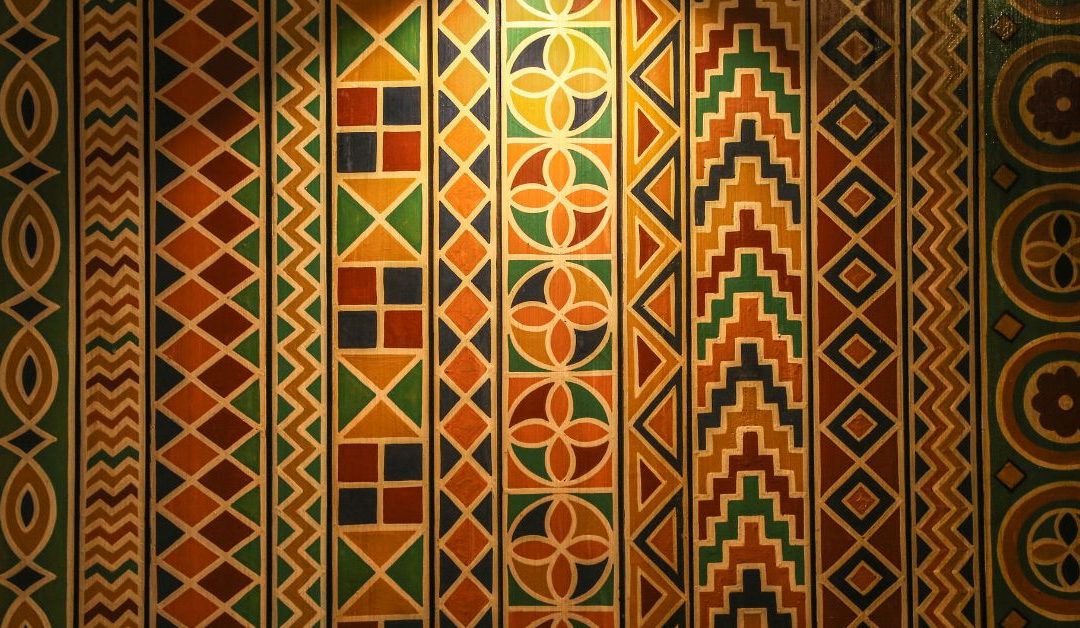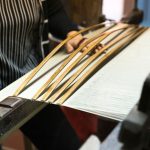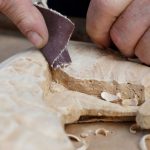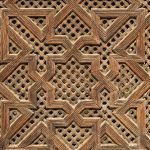People have been practicing Moroccan woodworking for a very long time, and it is an ancient and meaningful art. It’s a craft that is part of the country’s culture and history. The beautiful patterns made in the wood have special meanings.
I’m an expert in Moroccan woodworking, and I’m here to talk about what these designs symbolize.
The patterns made in the wood have spiritual meanings for Moroccans. They can protect against bad spirits and bring good luck. The meanings of these symbols can change depending on the region. Each pattern is unique and has its cultural significance.
In this article, I’ll explain how these shapes represent Morocco’s rich heritage and share what they mean.
The Meaning Behind The Star Shape
The star shape, also known as the Moroccan star, is an important symbol in traditional Moroccan woodworking. People have used the star shape to decorate palaces and homes for a long time because it holds cultural and spiritual significance. The star represents Islamic ideals like faith, friendship, strength, charity, wisdom, and guidance. When the star shape is then placed in a space, it brings a sense of prosperity and protection.
The intricate designs on wood pieces hold a special value that we can’t measure with ordinary things. These symbols tell a story about the region’s history through their art and meaning. They make us feel connected to the past and our ancestors.
Moroccan people use special designs. They use shapes like squares, triangles, and other geometric patterns on furniture and doors to show their culture. Each pattern has a special meaning, so it’s important to understand where it comes from and what it represents before trying to make it ourselves.
These patterns remind us that tradition is important in our lives today. They connect us to our heritage and help us appreciate our cultural identity. We should be proud of these symbolic shapes used in Moroccan woodworking.
Knowing all this helps us understand and admire the skill and work that goes into each piece created. It helps us feel more connected to our history and appreciate the beauty of our traditions.
The Significance Of The Hexagon
The hexagon is an important symbol in Moroccan woodworking, as it has both cultural and religious influences. In the Islamic faith, it represents a reminder of the unity between all things in life and the importance of balance. This is further reinforced by its association with the stars overhead that offer guidance for our daily lives.
The hexagon shape is very important in Moroccan culture. It represents perfection and reminds us to live our lives with intention and kindness toward others. In traditional Moroccan designs, people used the hexagon shape in buildings and furniture. This is to create harmony and make things look beautiful.
Craftsmen created patterns to fill up empty spaces and form intriguing shapes when viewed from different angles. These patterns are still used today in jewelry, clothes, and home decorations. People can adapt the hexagon patterns to fit modern styles while still keeping their special meaning.
The hexagon is a shape that connects people from different cultures, no matter where or when they are from. It demonstrates that everyone can appreciate and understand beauty regardless of their background.
The Symbolism Of The Circle
The circle is a symbol that represents unity, wholeness, and perfection in Moroccan woodworking. It is a shape that has no beginning or end, like a continuous flow that connects the past, present, and future.
Many spiritual traditions have used this symbol to represent divine energy and provide protection to those who wear it. In woodworking, circles have a deeper meaning than a shape. People use circles to bring harmony to Moroccan homes, and they can see them in doorways and furniture designs. Circles remind us that life is always changing but still connected.
Many people believe that circles bring good luck and positive energy to everyone who enters. They may seem simple, but they hold centuries of history and tradition in Moroccan art. By understanding the symbolism of circles, we can appreciate how important they are in our lives today.
When we carve a circle into something new, we become part of the ongoing story of Moroccan culture and craftsmanship. This story will continue for many more generations to come.
The Significance Of The Square
In Moroccan woodworking, different shapes have special meanings. The circle is a popular symbol that represents the cycle of life and eternity. It can have religious significance and represent infinite power.
The square is another common shape used by Moroccan artisans, and it symbolizes stability, balance, and direction. It can represent protection and order.
Triangles are much used in Moroccan woodworking and they symbolize strength and dignity. In Islamic culture, triangles are important for honoring ancestors. Plus, they represent wisdom and guidance during difficult times.
These shapes have deep meanings and are not only for decoration. They convey messages about people’s beliefs and values. Each shape has its special meaning. But, together they show the traditional craftsmanship of Morocco and go beyond looking nice.
With this in mind, what lies behind the triangle?
The Meaning Behind The Triangle
Geometric patterns are important in Moroccan woodworking. One very special shape is the triangle. In Moroccan culture, the triangle holds a lot of meaning that people have passed down through generations.
Triangles have three sides, and each side represents something different. These include feelings, meanings, or even numbers. This makes the triangle a symbol with deep cultural significance in Morocco.
| Meaning | Feeling | Number |
| Earth | Stability | 3 |
| Sky | Spiritual Journey | 9 |
| Sea | Rebirth | 12 |
In traditional Morocco, people used symbols to teach important lessons and wisdom from one generation to another. For example, the earth symbol represents stability, reminding us to stay focused on our goals even when things get tough. When we combine the elements of sky, sea, and earth, they create a strong foundation for our spiritual growth and help us find inner balance and peace. The triangle is a powerful symbol that speaks to our soul and guides us on our journey.
Now, let’s talk about the oval shape.
The Significance Of The Oval Shape
In Moroccan woodworking, the triangle and oval shapes have special meanings. The oval shape represents unity and eternity. It is often used as a decorative element on furniture. The colors used to paint or stain ovals also have meanings. Blues and greens represent life and growth, while reds symbolize protection.
Ovals have significance in Moroccan culture because they are also found in Islamic architecture. They have a spiritual meaning aside from representing strength and stability in the home. When people use ovals along with other shapes like triangles and rectangles, they create a beautiful balance in the design.
Shapes are important in creating meaningful designs. Each shape has its special significance. As we learn about different shapes, we can understand how they work together to make stunning works of art.
The Symbolism Of The Rectangle
In Moroccan woodworking, the rectangle shape is very important. You can find the rectangle shape in the beautiful designs on furniture like ottomans and tables.
From a spiritual point of view, the rectangle represents balance and stability. It shows how opposite things can work together, like yin and yang. It has cultural meaning, as families use it to mark special occasions or important moments in life.
Craftsmen use the rectangle shape to highlight designs in their wood carvings. They believe it brings good luck and prosperity to the owners of the furniture.
The patterns with rectangles also protect against evil spirits. Nowadays, Moroccans still use geometric patterns in their woodwork. This is because of the meanings and their connection with nature.
Craftsmen follow specific rules when making each piece. This is so they are not only beautiful but carry special meanings too related to rituals and beliefs. Rectangles give us a glimpse into Morocco’s culture. Plus, it shows us the spiritual significance behind the traditional techniques still used today.
With that said, I’d like to move on now to discuss the significance of the diamond shape…
The Significance Of The Diamond Shape
In Moroccan woodworking, the rectangle is a shape that represents stability and order. It is important to the people of Morocco because it symbolizes structure and balance.
Another shape used in Moroccan art is the diamond. It has a cultural origin in Islam, and each point of the diamond represents one of Allah’s messengers. People who practice Islam see diamonds as symbols of protection and guidance from God. In furniture making, craftsmen use the diamond pattern to provide extra support for big pieces like tables or cabinets.
Diamonds are also associated with wealth because they are rare. When used in home decor, they give a feeling of luxury and make a space look special.
When you combine the diamond shape with other shapes, it makes the design look more detailed and interesting. It creates a cool pattern that adds texture to the look.
Now we move on to explore the meaning behind the wave pattern; an iconic image commonly seen across various forms of Moroccan artwork…
The Meaning Behind The Wave Pattern
In Moroccan woodworking, one of the most common patterns is the wave pattern. It holds a special meaning and connects to their culture. The wave pattern represents energy and the connection between different parts of life.
People believe that the wave pattern brings positive energy and protects them from bad things. It symbolizes balance in nature and the flow of time. You can find this pattern in traditional Moroccan homes on walls and ceilings. It’s not only for looks; it as well helps people connect with spiritual things.
People have passed down this belief for many years, and it is still followed today. Even modern homes use wave designs to honor tradition or make their space look nice. Artisans use materials like wood or metal to make these patterns and show their skills. Artisans create each piece with great care, ensuring that it holds a deeper meaning.
The wave pattern is one example of how designs in Moroccan culture have special meanings. In the next topic, we’ll learn about the significance of the spiral pattern and how it connects to Moroccan traditions.
The Significance Of The Spiral Pattern
In Moroccan woodworking, the spiral pattern holds great importance. People have been using it for a long time, and it carries a special meaning. The spiral represents the movement of life, with no beginning or end. It shows that things continue forever.
The spiral pattern comes from ancient cultures in North Africa, especially the Berber tribes in Morocco. They believed the spiral represented the sun’s rays moving through the sky each day. It reminded them to stay connected with nature and time.
The spiral also has spiritual meanings. Some people see it as a symbol of God’s power and protection. In Morocco, many homes have these patterns carved into doorways or windowsills for good luck and blessings.
No matter how you understand it, the spiral has a deep meaning in Moroccan tradition. Craftsmen have been making it with great care for many generations, and it will continue for many more years to come.
Frequent-Asked Questions
What Type Of Wood Do Moroccan Woodworkers Use In Moroccan Woodworking?
In Moroccan woodworking, the kind of wood used depends on what is being made. For furniture like tables and chairs, artisans often use dark-colored woods like cedar, walnut, or mahogany. Artisans use lighter wood like pine for decorative purposes such as making wall panels or door frames.
Artisans can make the wood even more special by carving detailed geometric patterns into it. This adds a special meaning to the design.
How Are Geometric Patterns Used For Decoration?
In Moroccan woodworking, geometric patterns are very important and have a special meaning. Craftsmen use lines, circles, and shapes like polygons to create these patterns. They use them to make furniture and decorations look pretty and attractive.
The geometric shapes are not only for decoration, though. They represent balance, harmony, and order in the world, which is a big idea in Islamic culture. When the craftsmen use these shapes in their work, they are showing respect for this idea and make something beautiful at the same time.
Are There Any Cultural Traditions Associated With Moroccan Woodworking?
People in Morocco have been practicing woodworking for a very long time, and each region has its unique customs and traditions.
People in Morocco use wood to make different things, like furniture and doors. They often decorate these items with geometric patterns. These patterns are important because they have meanings that come from the culture and beliefs of the people. Some shapes might represent good luck or fertility.
In some places, many villages have similar traditions when it comes to woodworking. They all share the same customs and practices.
It’s no surprise then that much of what we see today is still influenced by such longstanding methods.
Are There Any Other Shapes Or Patterns Used In Moroccan Woodworking?
Moroccan woodworking is an amazing art! They decorate the wooden furniture with beautiful colors and designs that make it look stunning. They use different shapes like crescent moons and spirals, and patterns like stars, diamonds, and zigzags. These make the woodwork look even more special and interesting.
People use Moroccan woodwork for different reasons. They might use it because it’s important for their religion, or they use it to make their homes and workspaces look nice.
What Methods Do Artisans Use To Create These Geometric Patterns?
Moroccan woodworking is famous for its detailed patterns made with special tools. First, the craftsman chooses the right wood for a smooth surface. They use saws to make straight lines and shape the design. Then, they use gouges and chisels for more detailed work. Finally, sanding blocks make everything smooth. With these steps, skilled craftspeople turn simple materials into beautiful furniture and decorations.
People in Morocco have been practicing Moroccan woodworking, which is a beautiful and meaningful art, for many years. The use of shapes and patterns in this craft creates a stunning and captivating look. These patterns can express different emotions and tell stories that are important in Moroccan culture.
The woodworking in Morocco reflects our country’s history and traditions. It’s amazing how it continues to be valuable even with modern techniques around. It is a remarkable piece of artwork that represents the spirit of Morocco!







